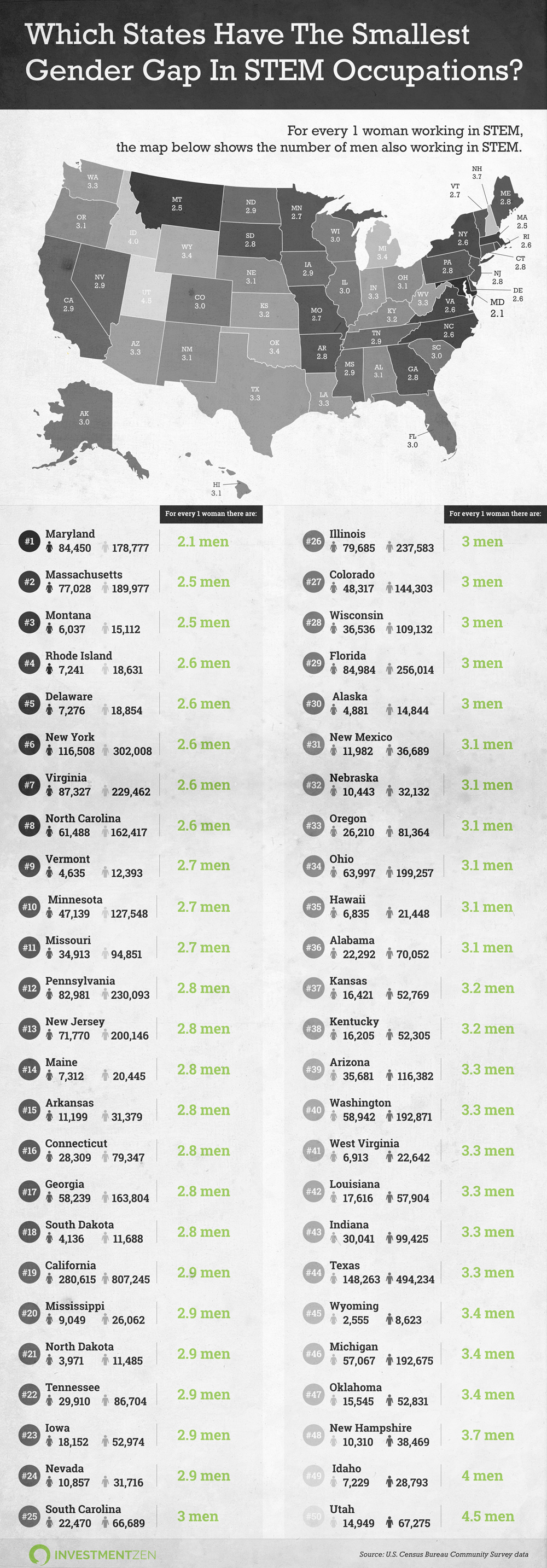Women make up just over one fourth of manufacturing employees, yet 47 percent of the total United States labor force. That makes them the largest pool of untapped talent in the U.S. Even more, women earn more than half of the associate’s, bachelor’s and master’s degrees. Once in the workforce, they are advancing in their careers, holding more than half of all U.S. managerial and professional positions. So why aren’t these women choosing a career in manufacturing?
In general, women are underrepresented in STEM fields across the country. In her infographic below, Hazel Garcia from Investmentzen illustrates how many men are in STEM (computer, engineering, and science) occupations for every 1 woman in each state.

The movement to bring more women to manufacturing isn’t only important to girls. The more people we encourage to pursue STEM, the more diverse our workplace is – and the more unique backgrounds we have solving the world’s issues.
To help business leaders attract more women to the field, we’ve compiled four ways the manufacturing industry can fill the gender gap.
1. Foster girls’ interest in manufacturing at an early age.
According to a study on women in manufacturing done by Deloitte, only 12 percent of respondents believe the K-12 school systems actively encourage girls to pursue careers in manufacturing, compared to 53 percent who believe it does not at all promote the field.
Participating manufacturing executives agreed molding impressions that may influence career choices, including manufacturing, should begin at a young age. Ideally, the pipeline should begin attracting students around fourth grade and maintain their interest through 12th grade. In order to do this, manufacturing leaders must partner with education decision makers at a national level.
By engaging teachers, they can understand the impact they have by encouraging students to pursue a STEM career. Programs such as the National Girls Collaborative Project, Dream It. Do It. and Schools2Skills are a few of The Manufacturing Institute’s ways of engaging students, parents and educators in manufacturing activities.
2. Offer female manufacturing mentors.
Women are underrepresented in nearly every manufacturing sector in the U.S. They’re seldom seen in top-level boxes positions, too, lagging behind the proportion of women in leadership at other types of companies. By providing young women with manufacturing mentors, they’ll have the opportunity to see first hand that women can be successful in these types of careers.
Mentors have a personal interest in the success of their mentees and are dedicated to helping them build confidence, connect grow professionally and secure jobs.
While some mentorships occur naturally, many credible organizations offer structured programs. The Association for Women in Science, Association for Women in Mathematics, Women in Technology International and Society of Women Engineers, to name a few, all connect young women with willing experts.
3. Provide them with better pay.
A large factor of women’s disinterest in manufacturing is the perceived pay inequality. In the Deloitte study, respondents ranked opportunities for challenging and interesting assignments, attractive pay and work-life balance as the top three most important priorities.
More than 70 percent indicated their experience causes them to believe there is a pay gap between men and women in the industry (with wages higher for men). According to the Bureau of Labor Statistics, women earn about 82 percent of what men do (even less during childbearing years). In manufacturing, there’s an even wider gap:
- First-line supervisors of production and operating workers (70 percent wage gap)
- Production, planning and expediting clerks (72 percent wage gap)
- Production workers / all others (73 percent wage gap)
Manufactures can do their part to make sure their female employees are being hired, paid and promoted fairly.
4. Change your brand’s perception.
A negative, outdated perception of manufacturing is deterring women from entering the industry. Here are some of the ways brands can improve their perception:
- Social media. Young professionals are looking to work for companies that have a good culture. By using social media to showcase your unique culture, you can recruit women through their social networks.
- Flexibility. Only one in three respondents think the industry allows people to meet family commitments without impairing their career. Flexibility is important for women – it leads to job satisfaction, job engagement, mental health status and a higher likelihood of remaining with one’s current employer. Some companies recognize and reward individuals and teams who drive results, regardless of when and where work is being done.
- Training programs. Another way to show women that they can have a great career in manufacturing is by providing them with opportunities for professional growth. Manufacturing businesses can offer training programs or
Women in manufacturing: What’s next?
What is your manufacturing organization doing to fill the manufacturing gender gap? We’d like to hear from you. Let us know by tweeting us at @AppleRubber.
